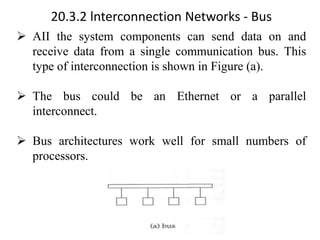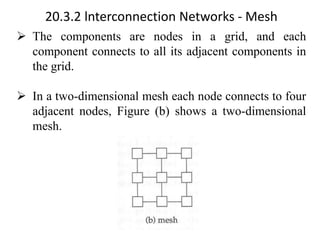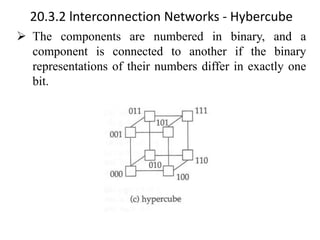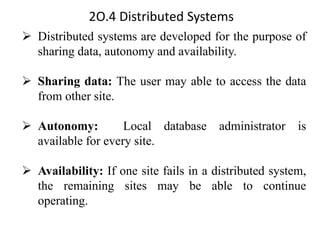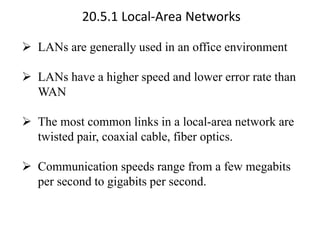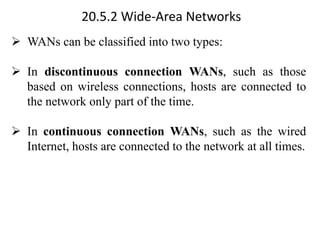Lecture Notes Unit3 chapter20 - Database System Architectures
- 1. RDBMS - Unit III Chapter 20 Database System Architectures Prepared By Dr. S.Murugan, Associate Professor Department of Computer Science, AlagappaGovernment Arts College, Karaikudi. (Affiliated by AlagappaUniversity) Mailid: [email protected] Reference Book: Database System Concepts by Abraham Silberschatz, Henry F.Korth , S. Sudharshan
- 2. Database System Architectures – Client Server Database System ➢ Networking of computers allows some tasks to be executed on a server system and some tasks to be executed on client systems. ➢ This division of work has led to client- server database systems.
- 3. Database System Architectures – Parallel Processing System ➢ Parallel processing is a method of simultaneously breaking up and running program tasks on multiple microprocessors, thereby reducing processing time. ➢ Parallel processing may be accomplished via a computer with two or more processors or via a computer network. ➢ Parallel processing is also called parallel computing
- 4. Database System Architectures – Parallel Processing System
- 5. Database System Architectures – Distributed Data Processing System ➢ Distributed data processing is a computer-networking method in which multiple computers across different locations share computer-processing capability.
- 6. 2O.1 CentraIized and Client - Server Architectures ➢ A modern, general-purpose computer system consists of one to a few CPUs and a number of device controllers that are connected through a common bus that provides accessto shared memory as shown in Figure 20.1.
- 7. 2O.1 CentraIized and Client - Server Architectures ➢ A computer system may be single user or multi user. ➢ A typical single-user system is a desktop unit used by a single person, usually with only one CPU and one or two hard disks, and usually only one person using the machine at a time. ➢ A typical multiuser system, on the other hand, has more disks and more memory, may have multiple CPUs and has a multiuser operating system. ➢ It serves a large number of users who are connected to the system via terminals.
- 8. 20.1.2 Client-Server Systems ➢ The centralized systems today act as server systems that satisfy requests generated by client systems. Figure 20.2 shows the general structure of a client- server system.
- 9. 20.1.2 Client-Server Systems ➢ The function of database can be broadly divided into two parts. One is front-end and another one is Back- end as shown in Figure 20.3. ➢ The front-end of a database system consists of tools such as SQL user interface, forms interfaces, report Generation. ➢ The back end manages access structures and query Evaluation. ➢ The interface between the front end and the back end is through SQL, or through an application program.
- 11. 2O.2 Server System Architecture ➢ Server systems can be broadly categorized as transaction servers and data servers. ➢ Transaction-server systems, also called query- server which receives the answer from the server based on the client request. ➢ Data-server systems allow clients to interact with the servers by making requests to read or update data.
- 12. 20.2.1 Transaction-Server Process Structure ➢ A transaction-server system consists of multiple processes accessing data in shared memory, as in Figure 20.4. The processes that form part of the database system include. ➢ Server processes: These are processes that receive user queries (transactions), execute them, and send the results back to the client. ➢ Lock manager process: It includes lock grant, lock release, and deadlock detection.
- 13. 20.2.1 Transaction-Server Process Structure ➢ Database writer process: The output can be stored from spool into hard disk and user records. ➢ Log writer process: outputs log records from the log record buffer to stable storage. ➢ Process monitor process: It takes recovery actions.
- 14. 20.2.1 Transaction-Server Process Structure
- 15. 2O.2 Server System Architecture ➢ Data-server systems are used in local-area networks, where there is a high-speed connection between the clients and the server, the client machines are comparable in processing power to the server machine, and the tasks to be executed are computation intensive. ➢ In such an environment, it makes sense to ship data to client machines, to perform all processing at the client machine (which may take a while), and then to ship the data back to the server machine. ➢ Note that this architecture requires full back-end functionality at the clients. ➢ Data-server architectures have been particularly popular in object-oriented database systems.
- 16. 2O.3 Parallel Systems ➢ Parallel systems improve processing and I/O speeds by using multiple CPUs and disks in parallel. ➢ In parallel processing, many operations are performed simultaneously, as opposed to serial processing, in which the computational steps are performed sequentially. ➢ A coarse-grain parallel machine consists of a small number of powerful processors. ➢ A massively parallel or fine-grain parallel machine uses thousands of smaller processors.
- 17. 2O.3 Parallel Systems There are two main measures of performance of a database system: (1) throughput, the number of tasks that can be completed in a given time interval, and (2) response time, the amount of time it takes to complete a single task from the time it is submitted.
- 18. 20.3.1 Speedup and Scaleup ➢ Two important issues in studying parallelism are speedup and scaleup. ➢ Running a given task in less time by increasing the degree of parallelism is called speedup. ➢ Handling larger tasks by increasing the degree of parallelism is called scaleup.
- 19. 20.3.1 Speedup and Scaleup
- 20. 20.3.1 Speedup and Scaleup
- 21. 20.3.2 lnterconnection Networks ➢ Parallel systems consist of a set of components (processors, memory, and disks) that can communicate with each other via an interconnection network ➢ Figure 20.7 shows three commonly used types of interconnection networks: (i) Bus (ii) Mesh (iii)Hybercube
- 22. 20.3.2 lnterconnection Networks - Bus ➢ AII the system components can send data on and receive data from a single communication bus. This type of interconnection is shown in Figure (a). ➢ The bus could be an Ethernet or a parallel interconnect. ➢ Bus architectures work well for small numbers of processors.
- 23. 20.3.2 lnterconnection Networks - Mesh ➢ The components are nodes in a grid, and each component connects to all its adjacent components in the grid. ➢ In a two-dimensional mesh each node connects to four adjacent nodes, Figure (b) shows a two-dimensional mesh.
- 24. 20.3.2 lnterconnection Networks - Hybercube ➢ The components are numbered in binary, and a component is connected to another if the binary representations of their numbers differ in exactly one bit.
- 25. 20.3.3 Parallel Database Architectures ➢ There are several architectural models for parallel machines. ➢ Among the most prominent ones are those in Figure 20.8 (in the figure, M denotes memory, P denotes a processor, and disks are shown as cylinders):
- 26. 20.3.3 Parallel Database Architectures ➢ Shared memory. All the processors share a common memory (Figure 20.8a). ➢ Shared disk. All the processors share a common set of disks (Figure 20.8b). Shared-disk systems are sometimes called clusters. ➢ Shared nothing. The processors share neither a common memory nor common disk (Figure 20.8c). ➢ Hierarchical. This model is a hybrid of the preceding three architectures (Figure 20.8d)
- 27. 20.3.3 Parallel Database Architectures
- 28. 2O.4 Distributed Systems ➢ In a distributed database system, the database is stored on several computers. ➢ The computers in a distributed system communicate with one another through various communication media, such as high-speed networks or telephone lines. The general structure of a distributed system appears in Figure 20.9.
- 29. 2O.4 Distributed Systems S.No. Shared Nothing Parallel DB Distributed DB 1. Parallel databases are not geographically separated, not separately administrated and have a faster interconnection. Distributed databases are geographically separated, separately administered, and have a slower interconnection. 2. There is no difference in local transaction and global transaction. There is a difference between local transaction and global transaction. In local transaction, accesses data only from sites where the transaction was initiated. In global transaction, accesses data in several different sites.
- 30. 2O.4 Distributed Systems ➢ Distributed systems are developed for the purpose of sharing data, autonomy and availability. ➢ Sharing data: The user may able to access the data from other site. ➢ Autonomy: Local database administrator is available for every site. ➢ Availability: If one site fails in a distributed system, the remaining sites may be able to continue operating.
- 31. 20.4.1 An Example of Distributed Database ➢ Consider a banking system consisting of four branches in four different cities. ➢ Each branch has its own computer, with a database of all the accounts maintained at that branch. ➢ There also exists one single site that maintains information about all the branches of the bank. ➢ Each branch maintains a relation account (Account_schema), where Account_schema = (account_number, branch_name, ba lance)
- 32. 20.4.1 An Example of Distributed Database ➢ The site containing information about all the branches of the bank maintains the reIation branch (Branch_schema), where Branch_schema= (branch_name, branch_city, assets) ➢ If the data were accessed from single site for the transaction is called local transaction. For ex, fund transfer from Account A to Account B in the same branch with the same city. ➢ If the data were accessed from multiple site for the transaction is called global transaction. For ex, fund transfer from Account A to Account B in the same branch with the different city.
- 33. 20.4.2 lmplementation lssues ➢ Atomicity of transactions is an important issue in building a distributed database system. ➢ If a transaction runs across two sites, it may commit at one site and abort at another, leading to an inconsistent state. ➢ This problem solved by the two-phase commit protocol (2PC). ➢ The coordinator decides to commit the transaction only if the transaction reaches the ready state at every site where it executed; otherwise (for example, if the transaction aborts at any site), the coordinator decides to abort the transaction.
- 34. 20.4.2 Implementation lssues ➢ Concurrency control is another issue in a distributed database. ➢ Since a transaction may access data items at several sites, transaction managers at several sites may need to coordinate to implement concurrency control. ➢ If locking is used, locking can be performed locally at the sites containing accessed data items, but there is also a possibility of deadlock involving transactions originating at multiple sites. ➢ Therefore deadlock detection needs to be carried out across multiple sites.
- 35. 20.4.2 Implementation lssues ➢ The primary disadvantage of distributed database systems are: ➢ Software-development cost is high. ➢ Greater potential for bugs. ➢ Increased processing overhead.
- 36. 2O.5 Network Types ➢ Distributed databases and client-server systems are built around communication networks. ➢ There are basically two types of networks: local-area networks and wide area networks. S.No . Local Area Network Wide Area Network 1. processors are distributed over small geographical areas, such as a single building or a number of adjacent buildings. a number of autonomous processors are distributed over a large geographical area (such as the United States or the entire world)
- 37. 20.5.1 Local-Area Networks ➢ Local-area networks (LANs) (Figure 20.10) emerged in the early 1970s as a way for computers to communicate and to share data with one another.
- 38. 20.5.1 Local-Area Networks ➢ LANs are generally used in an office environment ➢ LANs have a higher speed and lower error rate than WAN ➢ The most common links in a local-area network are twisted pair, coaxial cable, fiber optics. ➢ Communication speeds range from a few megabits per second to gigabits per second.
- 39. 20.5.1 Local-Area Networks ➢ A storage-area network (SAN) is a special type of high-speed local-area network designed to connect large banks of storage devices (disks) to computers that use the data (see Figure 20.11).
- 40. 20.5.2 Wide-Area Networks ➢ The first WAN to be designed and developed was the Arpanet. Work on the Arpanet began in 1968. ➢ The Arpanet has grown from a four-site experimental network to a worldwide network of networks, the Internet comprising hundreds of millions of computer systems. ➢ Data rates for wide-area links typically range from a few megabits per second to hundreds of gigabits per second. ➢ The last link, to end user sites, is often based on digital subscriber line (DSL) technology or cable modem or dial-up modem
- 41. 20.5.2 Wide-Area Networks ➢ WANs can be classified into two types: ➢ In discontinuous connection WANs, such as those based on wireless connections, hosts are connected to the network only part of the time. ➢ In continuous connection WANs, such as the wired Internet, hosts are connected to the network at all times.





















